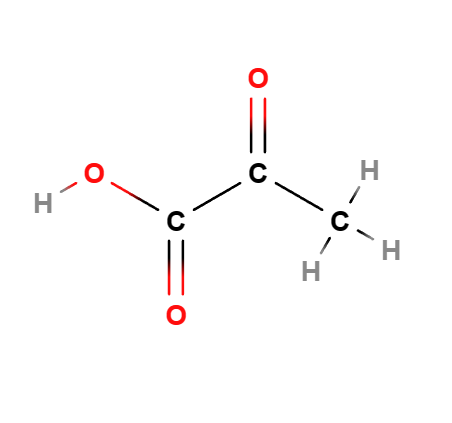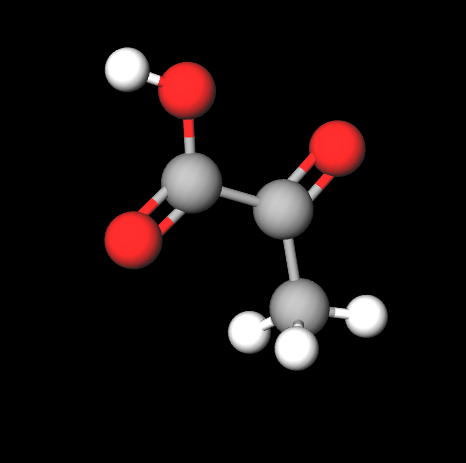![]() Pyruvic Acid
Pyruvic Acid
Rating : 7
| Evaluation | N. Experts | Evaluation | N. Experts |
|---|---|---|---|
| 1 | 6 | ||
| 2 | 7 | ||
| 3 | 8 | ||
| 4 | 9 | ||
| 5 | 10 |
Pros:
Skin protective (1)0 pts from admin
| Sign up to vote this object, vote his reviews and to contribute to Tiiips.Evaluate | Where is this found? |
| "Descrizione" about Pyruvic Acid by admin (19557 pt) | 2024-Apr-19 09:49 |
| Read the full Tiiip | (Send your comment) |
Pyruvic acid is an alpha-keto acid naturally occurring in the human body and in various foods. It plays a crucial role in metabolism, where it serves as an intermediary in the Krebs cycle, contributing to energy production.
The name describes the structure of the molecule:
- Pyruvic, a key organic compound in the energy metabolism of cells. It is involved in the Krebs cycle, an essential part of cellular respiration.
- acid refers to a chemical substance that can release hydrogen ions and has a pH less than 7. Acids are commonly used in chemistry for their reactive properties.
Chemical Industrial Synthesis Process (1)
- Raw material selection. The production of pyruvic acid can start with the selection of carbohydrates such as glucose or using tartaric acid as the starting material.
- Fermentation. In the fermentation method, glucose is converted into pyruvic acid using specific strains of bacteria or yeasts under controlled conditions of temperature and pH.
- Chemical synthesis. Alternatively, pyruvic acid can be produced through chemical synthesis, which involves the decarboxylation of tartaric acid followed by further purification reactions.
- Purification. The reactive mixture obtained is purified using techniques such as vacuum distillation or crystallization to isolate the pyruvic acid.
- Crystallization. The purified pyruvic acid is further refined by crystallization to enhance the purity and quality of the final product.
- Drying. After crystallization, the product is dried to remove residual moisture and obtain a fine powder.
- Quality control. Each batch of pyruvic acid undergoes rigorous quality checks to ensure it meets the required purity and quality specifications for industrial applications.
What it is used for and where
In dermatology, pyruvic acid is used as an exfoliating and anti-aging agent in skin treatments. It helps stimulate cellular renewal by reducing imperfections, wrinkles, and improving skin texture. Pyruvic acid is also known to assist in treating acne, scarring, and pigmentation, as it accelerates the cell turnover process in the skin.
Cosmetics - INCI Functions
- Fragrance. It plays a very important role in the formulation of cosmetic products as it provides the possibility of enhancing, masking or adding fragrance to the final product, increasing its marketability. It is able to create a perceptible pleasant odour, masking a bad smell. The consumer always expects to find a pleasant or distinctive scent in a cosmetic product.
Main uses and benefits of pyruvic acid
Anti-Aging Treatments. Pyruvic acid stimulates the production of collagen and elastin, helping to reduce fine lines and wrinkles and improving skin elasticity.
Chemical Exfoliation. Used in chemical peels, pyruvic acid helps remove the top layer of dead skin cells, revealing a fresher, younger layer.
Acne Treatment. It has antibacterial properties and can help prevent the clogging of pores, thereby reducing acne formation and improving skin clarity (2).
Scar and Spot Reduction. It is effective in reducing the appearance of scars, including post-inflammatory hyperpigmentation, due to its ability to accelerate cell renewal (3).
Improvement of Skin Texture. It contributes to improving the overall texture of the skin, making it smoother and more even (4).
Use in Combination with Other Acids. It is often combined with other exfoliating acids to enhance their effectiveness and results, especially in professional treatments.
 |  |
Molecular Formula C3H4O3
Molecular Weight 88.06 g/mol
CAS 127-17-3
UNII 8558G7RUTR
EC Number 204-824-3
DTXSID2021650
Synonyms
Acid Pyruvic
Pyruvate
Bibliografia_____________________________________________________________________
(1) Li Y, Chen J, Lun SY. Biotechnological production of pyruvic acid. Appl Microbiol Biotechnol. 2001 Nov;57(4):451-9. doi: 10.1007/s002530100804.
Abstract. Pyruvic acid is an important organic acid widely used in the chemical and drug, as well as agrochemical, industries. Compared with the chemical method, biotechnological production of pyruvic acid is an alternative approach because of the low cost. An overview of biotechnological production of pyruvate, including direct fermentative production employing eukaryotic and prokaryotic microorganisms, production by a resting cell method and an enzymatic method as well as the recovery of pyruvate, is discussed. A multi-vitamin auxotrophic yeast strain, Torulopsis glabrata. has been used in the commercial production of pyruvate; emphasis is therefore placed on the mechanism and characteristics of pyruvate production by this strain.
Cybulski K, Tomaszewska-Hetman L, Rakicka M, Juszczyk P, Rywińska A. Production of pyruvic acid from glycerol by Yarrowia lipolytica. Folia Microbiol (Praha). 2019 Nov;64(6):809-820. doi: 10.1007/s12223-019-00695-2.
Abstract. The aim of the study was to screen Yarrowia lipolytica strains for keto acid production and determine optimal conditions for pyruvic acid biosynthesis from glycerol by the best producer. The analyzed parameters were thiamine concentration, medium pH, stirring speed, and substrate concentration. The screening was performed in flask cultures, whereas pyruvic acid production was carried out in 5-L stirred-tank reactor with 2 L of working volume. In total, 24 Y. lipolytica strains were compared for their abilities to produce pyruvic and α-ketoglutaric acids. The total concentration of both acids ranged from 0.1 to 15.03 g/L. Ten strains were selected for keto acid biosynthesis in bioreactor. The Y. lipolytica SKO 6 strain was identified as the best producer of pyruvic acid. In the selected conditions (thiamine concentration 1.5 μg/L, pH 4.0, stirring speed 800 rpm, 150 g/L of glycerol), the strain Y. lipolytica SKO 6 produced 99.3 g/L of pyruvic acid, with process yield of 0.63 g/g and volumetric production rate of 1.18 g/L/h. Higher titer of pyruvic acid was obtained during fed-batch culture with 200 g/L of glycerol, reaching 125.8 g/L from pure glycerol (yield 0.68 g/g) and 124.4 g/L from crude glycerol (yield 0.62 g/g). Results obtained for the strain Y. lipolytica SKO 6 proved the suitability of microbial production of pyruvic acid at industrial scale.
(2) Chilicka K, Rogowska AM, Szyguła R, Dzieńdziora-Urbińska I, Taradaj J. A comparison of the effectiveness of azelaic and pyruvic acid peels in the treatment of female adult acne: a randomized controlled trial. Sci Rep. 2020 Jul 28;10(1):12612. doi: 10.1038/s41598-020-69530-w. PMID: 32724156; PMCID: PMC7387545.
Abstract. Chemical peels are widely used as therapeutic agents in dermatology and cosmetology. This study aims to explore the differences in the effectiveness of azelaic and pyruvic acid peels in the treatment of acne vulgaris. Eligibility criteria for participants were: female gender, 18-25 years of age, no dermatological treatment within the last 12 months and mild to moderate papulopustular acne. We treated 120 young women (with a mean age of 22 years old) with six peeling sessions at 2-week intervals. In the parallel clinical study design, one randomized group (n = 60, 50%) was treated using azelaic acid (AA), whereas the second group participated in pyruvic acid (PA) sessions. We evaluated the patients clinically twice (before and after treatment), using the Scale of Hellegren-Vincent Severity Symptoms to assess the acne diagnosis, and the Nati Analyzer to estimate the skin properties (oily skin, desquamation, porosity, and moisture). The clinical evaluation of the patients demonstrated a significant reduction of acne severity symptoms in both the AA and PA groups, after the peeling sessions. An effect was also found in terms of decreasing desquamation and the oiliness of the skin. PA showed a more significant reduction of greasy skin than AA. In conclusion, after the six peeling sessions using AA and PA, all patients showed better skin parameters in term of reduced oiliness and desquamation. Both AA and PA peelings are a safe and efficient treatment for mild acne, however, during the selection of one of the two acids, side effects, skin properties, and patients' preferences should be taken into account. This study was registered in the ISRCTN registry (registration number ISRCTN79716614, 17/01/2020).
(3) Ghersetich I, Brazzini B, Peris K, Cotellessa C, Manunta T, Lotti T. Pyruvic acid peels for the treatment of photoaging. Dermatol Surg. 2004 Jan;30(1):32-6; discussion 36. doi: 10.1111/j.1524-4725.2004.30002.x.
Abstract. Background: Pyruvic acid (CH3-CO-COOH), an alpha-keto-acid, has been recently used as a medium chemical peeling agent in subjects with inflammatory acne, moderate acne scars, greasy skin, actinic keratosis, and warts. Objective: The aim of our study was to evaluate the efficacy and tolerability of 50% pyruvic acid on moderately photodamaged facial skin....Conclusion: Thus, 50% pyruvic acid peeling can be proposed as a safe and efficient treatment for moderate facial skin aging.
(4) Cavallini M, Montanaro F, Papagni M. A Topical Depigmentation Program Against Hyperpigmentation Enhances the Benefits of Previously Performed Chemical Peeling Procedures of the Face. J Cosmet Sci. 2020 Nov-Dec;71(6):385-397.
Abstract. Chemical peeling can reduce skin hyperpigmentation; however, once exhausted its thinning action, the depigmentation process does not continue further. We carried out a monocentric, prospective, noncontrolled study aimed at the evaluation of the efficacy, safety, ease of use, pleasantness, and tolerability of a depigmentation topical treatment program in women submitted to a previous chemical peeling. The topical treatment has been administered daily for 30 days to 16 women submitted to a chemical peeling containing a fixed-dose combination of salicylic acid, pyruvic acid, and retinoic acid within 7 days before study inclusion. Target skin areas have been evaluated for melanin concentration and skin texture before peeling and at study visits 1 (after peeling) and 2 (after the 30-day treatment). The topical treatment program induced a decrease in melanin concentration between study visits 1 and 2 (-4.74%; p = 0.0008). It reduced melanin concentration even further between the prepeeling period and visit 2 (-7.8%; p < 0.0001). Patients rated the depigmentation topical treatment program as "very simple" (87.5%) and "simple" (12.5%) to use and as "pleasant" (56.25%) and "very pleasant" (43.75%). Results support the use of the home-based depigmentation topical treatment program to potentiate the effectiveness of a previous chemical peeling in hyperpigmentation reduction.
| Sign up to vote this object, vote his reviews and to contribute to Tiiips.EvaluateClose | (0 comments) |
Read other Tiiips about this object in __Italiano (1)
Component type: Chemical Main substances: Last update: 2024-04-19 09:14:59 | Chemical Risk: |


